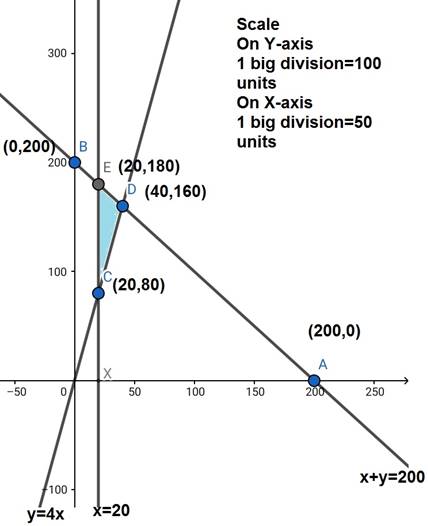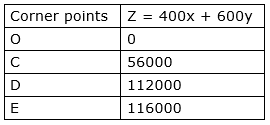An aeroplane can carry a maximum of 200 passengers. A profit of ₹ 400 is made on each first class ticket and a profit of ₹ 600 is made on each economy class ticket. The airline reserves at least 20 seats of first class. However, at least 4 times as many passengers prefer to travel by economy class to the first class. Determine how many each type of tickets must be sold in order to maximize the profit for the airline. What is the maximum profit.
Let required number of first class and economy class tickets be x and y respectively.
Each ticket of first class and economy class make profit of Rs 400 and Rs 600 respectively.
So, x ticket of first class and y tickets of economy class make profit of Rs 400x and Rs 600y respectively.
Let total profit be Z = 400x + 600y
Given, aeroplane can carry a minimum of 200 passengers, so,
x + y![]() 200
200
Given airline reserves at least 20 seats for first class, so,
x ![]() 20
20
Also, at least 4 times as many passengers prefer to travel by economy class to the first class, so
y ![]() 4x
4x
Hence the mathematical formulation of the LPP is
Max Z = 400x + 600y
Subject to constraints
x + y ![]() 200
200
y ![]() 4x
4x
x ![]() 20
20
x,y ![]() 0 [ since seats in both the classes can not be zero]
0 [ since seats in both the classes can not be zero]
Region represented by x + y ![]() 200: the line x + y = 200 meets the axes at A(200,0), B(0,200). Region containing origin represents x + y
200: the line x + y = 200 meets the axes at A(200,0), B(0,200). Region containing origin represents x + y ![]() 200 as (0,0) satisfies x + y
200 as (0,0) satisfies x + y ![]() 200.
200.
Region represented by x ![]() 20: line x = 20 passes through (20,0) and is parallel to y axis. The region to the right of the line x = 20 will satisfy the inequation x
20: line x = 20 passes through (20,0) and is parallel to y axis. The region to the right of the line x = 20 will satisfy the inequation x ![]() 20
20
Region represented by y ![]() 4x: line y = 4x passes through (0,0). The region above the line y = 4x will satisfy the inequation y
4x: line y = 4x passes through (0,0). The region above the line y = 4x will satisfy the inequation y ![]() 4x
4x
Region x,y ![]() 0: it represents the first quadrant.
0: it represents the first quadrant.

The corner points are C(20,80), D(40,160), E(20,180).
The values of Z at these corner points are as follows:

The maximum value of Z is attained at E(20, 180).
Thus, the maximum profit is Rs 116000 obtained when 20 first class tickets and 180 economy class tickets are sold.